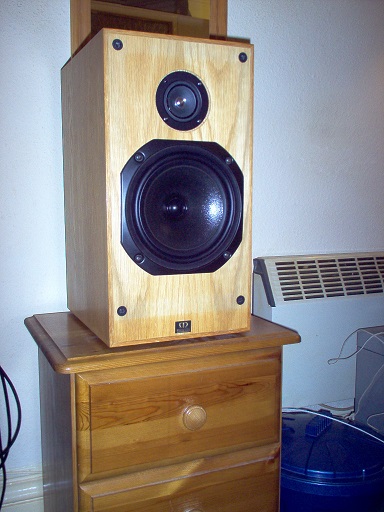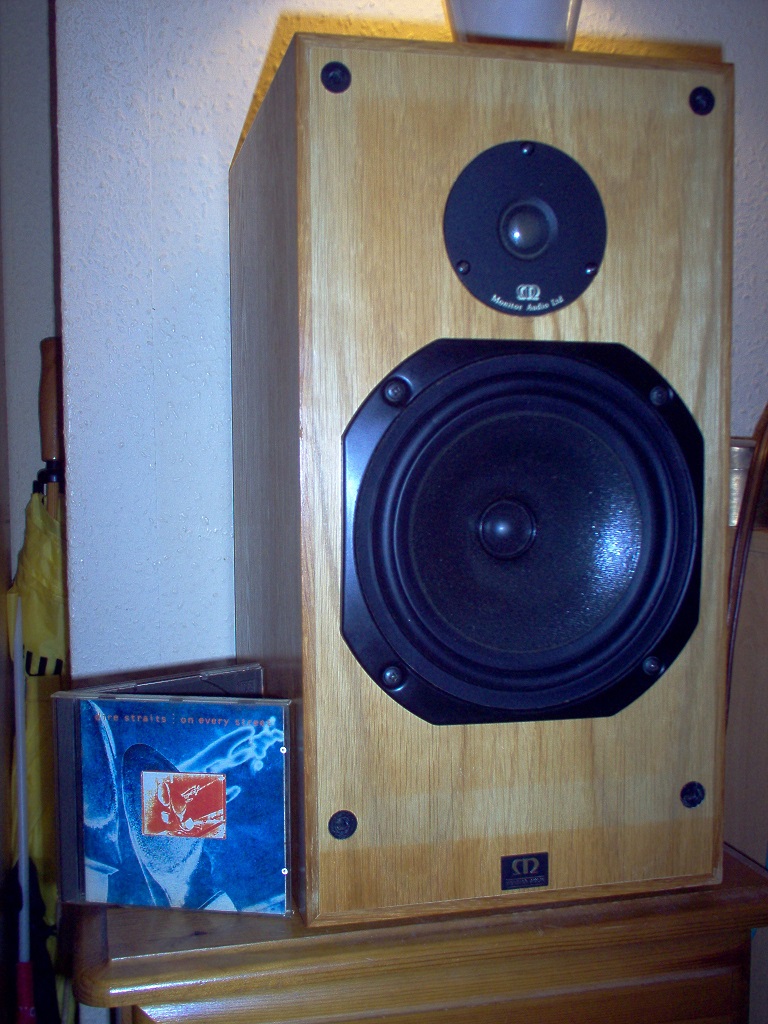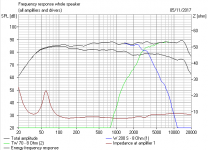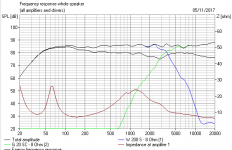Above/with.. if you can work with the slope then it's ok. The point was that above the notch the response will kink, marking the end of the usable band so the response should be out by that point (and not come back above it)...a need to retain a specific LP slope to keep the FR well behaved at the XO frequency which means its better to add a notch at a point abve XO point instead f steepening up the LP?
Power response is what your ears hear down the hallway from your room. Frequency response is what you hear in the room. It's a subtle distinction.
Here's a speaker I have built:

A biggish 2" cone tweeter falls off off-axis. It's how they work. So toe them in to your listening position.
I then did it another way. A small SEAS 3/4" metal dome has much greater dispersion.

These speakers have two very different sounds. It's not the frequency response that is wildly different. It's the power response. The smaller dome is spreading energy around the room, the bigger cone tends to direct it narrowly.
Visaton calls this "energy frequency response". It's the curve below the frequency response. And you can see the smaller dome gives much higher energy around 5kHz. Maybe annoyingly so. And it applies to bafflestep too, which can be avoided altogether by wallmounting the speaker. Interestingly, any sort of line-array loudspeaker sounds quieter to the neighbours, who are trying to sleep outside, whilst sounding just as loud to the people inside the venue on the dance floor who are still hopped up. Dispersion is a HUGE issue in loudspeakers.
Which is why MTM is a good idea, IMO.
Here's a speaker I have built:

A biggish 2" cone tweeter falls off off-axis. It's how they work. So toe them in to your listening position.
I then did it another way. A small SEAS 3/4" metal dome has much greater dispersion.

These speakers have two very different sounds. It's not the frequency response that is wildly different. It's the power response. The smaller dome is spreading energy around the room, the bigger cone tends to direct it narrowly.
Visaton calls this "energy frequency response". It's the curve below the frequency response. And you can see the smaller dome gives much higher energy around 5kHz. Maybe annoyingly so. And it applies to bafflestep too, which can be avoided altogether by wallmounting the speaker. Interestingly, any sort of line-array loudspeaker sounds quieter to the neighbours, who are trying to sleep outside, whilst sounding just as loud to the people inside the venue on the dance floor who are still hopped up. Dispersion is a HUGE issue in loudspeakers.
Which is why MTM is a good idea, IMO.
Attachments
Last edited:
Not necessarily, eg: A driver response is halved (-6dB) at crossover, its drive is -6dB and so is its current so, its power is one quarter (-6dB). Bring in the other driver and this power is now doubled (but still at -3dB), and the response is at 0dB where they combine constructively.Isn't a flat power response a flat frequency response in the real world? ..around the crossover frequency
I know, that's what I mean, there is a power response dip at crossover with a LR4 for example, can't this equate to a frequency response dip in the room?
The response gains 3dB coming from two drivers (when you measure it from where they combine constructively).
Consider a text book first order crossover where each driver is -3dB. Power is flat and so is response but only because the separate responses are 90 degrees out of phase, otherwise there is a response peak (off axis).
Power isn't measured this way.
Consider a text book first order crossover where each driver is -3dB. Power is flat and so is response but only because the separate responses are 90 degrees out of phase, otherwise there is a response peak (off axis).
Power isn't measured this way.
I think the truth is that there isn't a tremendously easy explanation of what is the best way to do things when matching acoustic response of two drivers into a single coherent whole.
For sure, even order slopes like LR2 and LR4 are a -6dB crossover on phase matched. And the power hole comes from the fact that even order slopes fall apart above and below axis into cancellation. Odd order slopes like BW3 tend to go for -3dB crossover at 90 degrees and flat power response. Kinda sound good all round the room.
Who's to say what is best? This is where I trust my knowledge of the Quantum Theory. Maxwell's classical equations assumed linearly polarised waves (Up and Down) as the building blocks. In fact, Quantum Theory (QFT) assumes that circularly polarised light (clockwise and anticlockwise) is the fundamental. Which adds the odd concept of Spin.
The Quantum Theory is provably right. And BW3 is a sort of circularly polarised light theory. Very odd indeed. We forego phase-alignment. And maybe it works better. I certainly like what 18dB/octave BW3 does. Exact time-alignment is a weird issue with BW3.
THAT may be related to the Planck relationship between Energy and time, or momentum and position. Two dualities. Difficult stuff, isn't it? LOL
For sure, even order slopes like LR2 and LR4 are a -6dB crossover on phase matched. And the power hole comes from the fact that even order slopes fall apart above and below axis into cancellation. Odd order slopes like BW3 tend to go for -3dB crossover at 90 degrees and flat power response. Kinda sound good all round the room.
Who's to say what is best? This is where I trust my knowledge of the Quantum Theory. Maxwell's classical equations assumed linearly polarised waves (Up and Down) as the building blocks. In fact, Quantum Theory (QFT) assumes that circularly polarised light (clockwise and anticlockwise) is the fundamental. Which adds the odd concept of Spin.
The Quantum Theory is provably right. And BW3 is a sort of circularly polarised light theory. Very odd indeed. We forego phase-alignment. And maybe it works better. I certainly like what 18dB/octave BW3 does. Exact time-alignment is a weird issue with BW3.
THAT may be related to the Planck relationship between Energy and time, or momentum and position. Two dualities. Difficult stuff, isn't it? LOL
Last edited:
All Butterworth filters are -3dB at crossover frequency, not just the odd order ones which Butterworth himself did not anticipate as his original paper only mentions even order ones.
system7,
It takes some easy peasy overhand of explanations doesn't it, why should gedlee use BW3 if it ruin his DI and why should wesayso if all it do is ruin his lines that run almost perfect without, we do what we do and if that means high-efficiency horn tweeters or full-range drivers its still multiway. Then claim is that power response matters, then its MTM is a good idea, well isn't MTM worse than MT in power response or is MTM choosen in your lab to repair unsymmetric tilted lobe from your prefered so called sort of circularly polarised light theory very odd indeed BW3 or where are we, ooh think we there where one possible repair for better power response in XO region is use less ctc spacing plus lower point of frq for XO than is the normal.
😉 be open minded and maybe also engineer a non-pass stage that filter out personal "high level physics" thinking into this thread, not too shallow but a properly steep one.
It takes some easy peasy overhand of explanations doesn't it, why should gedlee use BW3 if it ruin his DI and why should wesayso if all it do is ruin his lines that run almost perfect without, we do what we do and if that means high-efficiency horn tweeters or full-range drivers its still multiway. Then claim is that power response matters, then its MTM is a good idea, well isn't MTM worse than MT in power response or is MTM choosen in your lab to repair unsymmetric tilted lobe from your prefered so called sort of circularly polarised light theory very odd indeed BW3 or where are we, ooh think we there where one possible repair for better power response in XO region is use less ctc spacing plus lower point of frq for XO than is the normal.
😉 be open minded and maybe also engineer a non-pass stage that filter out personal "high level physics" thinking into this thread, not too shallow but a properly steep one.
Power response is what your ears hear down the hallway from your room. Frequency response is what you hear in the room. It's a subtle distinction.
I don't really think it is so subtle. The frequency response is what your ears hear as the direct field, the field where your brain form an "image" of where the sound is coming from - called "summing localization". The power response creates the reverberant field which is highly important for the timbre of the sound and the feeling of spaciousness in the room. These are hardly subtle distinctions, they are the essence of what we perceive.
The relationship between the frequency response and the power response is called the Directivity Index DI, which is both frequency and angle dependent. If the DI is flat along some axis where the frequency response is flat then you have a speaker where the direct field and the reverberant fields will have the same timbre and one that is neutral. Good speakers can do this, most cannot.
The higher the DI the greater the Direct/Reverberant ratio is, which is a key aspect of a rooms perception. I design for a flat DI above some lower frequency like 500 Hz. that is as high as practicable with a power response that is slightly falling towards 10 kHz. - maybe -3 dB from 500 Hz. to 10 kHz.
One more thing of note is that no amount of EQ can alter the DI. If its bad then it is always bad. Only good acoustical design can achieve a good DI.
Would a DI which is lowest, whilst still avoiding the early reflections result in a more homogenous reverberant field. Ie more spread over time and space?a flat DI above some lower frequency like 500 Hz. that is as high as practicable
Last edited:
I suppose that decay time per frequency (=reverberant field) depends also on materials on floor, ceiling,walls and furniture (plus acoustic treatment), how they reflect different frequencies (multiple order reflections). The first reclections are mostly attenuated with more directivity, that's where high DI works best.
Would a DI which is lowest, whilst still avoiding the early reflections result in a more homogenous reverberant field. Ie more spread over time and space?
A low DI could not achieve "still avoiding the early reflections" SInce it send sound in many more directions there is inherently more early reflections. And since the reverberant field is an integration of the sound from all directions, i.e. the power response, the DI is not a factor. So I would have to say "no" a low DI will not achieve what you suggest.
Critical to listening in a small room is the amount of time between the first arrival and the onset of reflections and reverberation. In an auditorium this time lag is very long and in a small room it is very short, except that in a small room it is highly dependent on the DI. The higher the DI the greater this time lag will be.
Power response is what your ears hear down the hallway from your room. Frequency response is what you hear in the room.
isn't it that - first of all - what we hear is always a sum of all on-axis and off-axis sound energy that reaches the eardrum in the first ~50 ms after the initial wavefront?
A low DI could not achieve "still avoiding the early reflections" SInce it send sound in many more directions there is inherently more early reflections
but not necessarily first (first order so to speak) reflections?
but not necessarily first (first order so to speak) reflections?
Not necessarily, but certainly the probability of reducing these first order reflections and the ability to do so certainly increases with increased DI.
IF I was putting together a TEAM to design the perfect speaker, and TBH people management is not my strength and I would leave that to wintermute (aka moderator Tony who is far better than me with managing people), I would certainly have Dr. Earl Geddes (the horn man), Planet10 (aka fullrange Dave), Joachim Gerhard, Lynn Olson, Troels Gravesen, wesayso (the array man), and marco_gea (who would be in charge of the production workshop and making sawdust). I'd hope to make a contribution myself, but am not the greatest team player. I can be annoying. 😱
AFAIK, the perfect military team has 7 members, each playing to each others' strengths and weaknesses. But the guy you MOST need is an Einstein: Thought Experiment: How Einstein Solved Difficult Problems
I am lucky enough to have met the Einstein (or Newton, or Riemann or Euler or Gauss) of digital and analog signal processing. Attended his lectures and tutorials at Imperial College, London. It's like watching Mark Knopfler play guitar. He makes it look easy. It's not! 😎
Come on. You want to know who he is, don't you? Professor Tony Constantinides. A star of a man. We just signed up to every course he did no matter how obscure, because he is brilliant, and most of all, ENTERTAINING.
I shall next get back on-topic in this thread. But that's enough for now. 😀
AFAIK, the perfect military team has 7 members, each playing to each others' strengths and weaknesses. But the guy you MOST need is an Einstein: Thought Experiment: How Einstein Solved Difficult Problems
I am lucky enough to have met the Einstein (or Newton, or Riemann or Euler or Gauss) of digital and analog signal processing. Attended his lectures and tutorials at Imperial College, London. It's like watching Mark Knopfler play guitar. He makes it look easy. It's not! 😎
Come on. You want to know who he is, don't you? Professor Tony Constantinides. A star of a man. We just signed up to every course he did no matter how obscure, because he is brilliant, and most of all, ENTERTAINING.
I shall next get back on-topic in this thread. But that's enough for now. 😀
Come on. You want to know who he is, don't you? A star of a man. We just signed up to every course he did no matter how obscure, because he is brilliant, and most of all, ENTERTAINING.
It does you honor that you have such devotion and respect for a mentor.
I too have such a man. He remains the smartest person that I have ever met. He is a well published nuclear physicist of impeccable character who was my adviser and lifelong friend. It's an honor to have such people in our lives.
A low DI could not achieve "still avoiding the early reflections" SInce it send sound in many more directions there is inherently more early reflections. And since the reverberant field is an integration of the sound from all directions, i.e. the power response, the DI is not a factor. So I would have to say "no" a low DI will not achieve what you suggest.
Critical to listening in a small room is the amount of time between the first arrival and the onset of reflections and reverberation. In an auditorium this time lag is very long and in a small room it is very short, except that in a small room it is highly dependent on the DI. The higher the DI the greater this time lag will be.
Earl, I suspect that you misunderstood Allen's question. My interpretation is that he is assuming a DI that's at least high enough to drastically reduce first reflections. He's then contemplating if it might be better to keep the DI near that level, rather than to increase it much further.
Stated that way, is a very different question and one whose practical answer is that its kind of moot.
It takes a DI of at least 9 dB to get a controlled pattern <90° which would be a minimum to being able to avoid first wall reflections. Achieving say a 12 dB DI that is flat and down to a lower frequency of say 500 Hz. would be darn near impossible. So I would say that it is an interesting question but kind of moot. I'd say get to 9 dB and then don't worry about it.
It takes a DI of at least 9 dB to get a controlled pattern <90° which would be a minimum to being able to avoid first wall reflections. Achieving say a 12 dB DI that is flat and down to a lower frequency of say 500 Hz. would be darn near impossible. So I would say that it is an interesting question but kind of moot. I'd say get to 9 dB and then don't worry about it.
Yes, thank you that is what I meant. Also I agree 500Hz would be too low to be practical trying to take this and probably unnecessary as well.Earl, I suspect that you misunderstood Allen's question. My interpretation is that he is assuming a DI that's at least high enough to drastically reduce first reflections. He's then contemplating if it might be better to keep the DI near that level, rather than to increase it much further.
- Status
- Not open for further replies.
- Home
- Loudspeakers
- Multi-Way
- Well I suppose the shallow vs. steep argument will just go on and on

